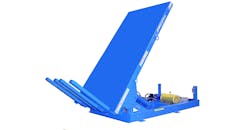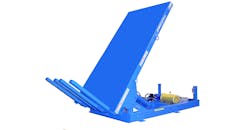Stronger, Lighter Upenders Handle More Applications
Most of the buzz around lighter-weight, less costly materials is focused on the auto and aerospace industries. In the transportation sectors, manufacturers are trying to find cost-effective ways to meet fuel efficiency mandates. But other industries are taking steps to improve performance and cut costs for customers through weight-reduction initiatives.
One sector that’s making advancements toward lighter-weight equipment is the material-handling industry. Advance Lifts plans to unveil a redeveloped upender line in July that will be stronger, lighter and more compact through a more efficient design, says Michael Renken, the company’s vice president.
“It used to be that steel was the cheapest thing there was,” Renken says. “When in doubt, throw more steel at it. Well, steel is not so cheap anymore. Our upenders are going on a massive diet, and they’re going be a stronger, more complete line in the process.”
Trimming the Fat … And Cost
The smaller, lighter-weight design will reduce costs for customers and open opportunities for more modifications, such as forks on one side instead of platforms, to complete a wider range of tasks.
“By better utilization of the steel and cylinder placement, we can reduce cost without sacrificing the quality of the product,” Renken says.
Upenders are devices that turn objects 90 degrees. Common applications include the movement of coils or rolls for industries, such as steel or paper. For example, in the paper industry, plant operators may need to access a roll that’s facing end up on a pallet. The upender can “down-end” the roll so the core is facing horizontally so a lift truck with a mandrel can pick up the roll and carry down an aisle.
“It’s a safe way to tip that roll on its side 90 degrees,” Renken says.
Renken estimated that the revamped upenders will be about 10% lighter than previous models. In addition, the weight reduction should result in cost savings for customers because there’s less steel in the product, Renken says.
Most of the weight reduction for Advance Lifts’ upenders is coming out of the base of the unit, Renken says. The units also are getting smaller by changing the location of different components, such as the power unit and hydraulic cylinder, for a more compact width.
Smaller, Larger, ‘Zero-Height’
Traditionally, customers didn’t want smaller units. But the desire for added comfort and safety has changed the way manufacturers design material-handling equipment, according to Renken.
“The times ergonomics are forcing people to try to manipulate smaller and smaller items with smaller and smaller equipment,” Renken explains. “Something that somebody wouldn’t think of trying to manipulate 20 years ago, people want to manipulate today. The big, early product of yesterday is still needed, but today smaller, lighter-duty equipment is required to manipulate these smaller products and not take up too much floor space.”
Advance Lifts redesigned upender line will include models that are up to 50% smaller than the smallest unit in its current line. The company also will offer units that are nearly 50% bigger for
applications that require a larger unit. For example, one Advance Lifts’ customer uses a larger upender to handle commercial-scale refrigerators that are commonly used in convenience stores. The company, which manufacturers refrigerators, uses the upender to work on different panels of the refrigerator during assembly, Renken says.
The revamped line will feature nearly 40 models with several options, including upenders with one side that lays flat on the ground – also called “zero-height.” Zero-height upenders are suitable for lifting anything that is ground-level, such as pallet, eliminating the need for a fork lift.
The increase in options are in response to market demand, Renken says.
“Customers are looking for more and more options,” he says. “They want them smaller, they want them larger, they want the zero height, and they want the standard features as well. But we’re seeing more and more requests for the smaller, larger and for them to be more accessible. People want to be able to roll a cart or a pallet jack on to one because they don’t have fork trucks or don’t use them in the area.”
About the Author

Jonathan Katz
Freelance Editor and Writer
Jonathan Katz, owner of JSK Communications, is a freelance writer with more than 15 years of experience in the publishing industry. He is the former managing editor for Cannabis Business Times and Cannabis Dispensary at GIE Media and a former managing editor of IndustryWeek magazine at Endeavor Business Media.
At IW, Katz covered a wide range of manufacturing topics, including automation, safety, facilities/plant operations and executive leadership.
Prior to freelancing, Katz served as a project manager for Content4Demand, a content marketing agency.

